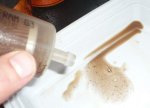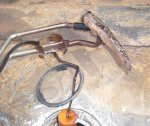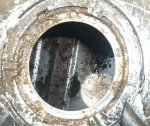top_prop
Member
- 243
- 8
- 18
- Location
- Suffolk, VA
I've had a few diesels.... and as always as they age they've gotten 'bugs' in the tanks now and then. I've always added bio shock to a nearly empty tank, refueled and repeated as necessary to kill the infection. Typically a few tanks of bio shock and a few filters and all is well. But the bugs have always been a dark, pretty much black goop.
I modified my My M1009 with a 3/8 inline filter near the tank and an electric fuel pump (removed Mech pump) and a napa spin on fuel filter base instead of the square standadyne. Its always had a few black clogged filters, but as long as I changed them with the oil all was well.
A couple months ago it started clogging filters with redish, brown, rust colored goop. Worried it was rust, I felt it... it was goopy and smooth, no grit. So I shocked and changed filters... its been about 6 tanks of fuel and it seems to be getting worse (ie I plugged a 3/8 primary and a spin on secondary in a week.... just changed them and got about 60miles out of it today before the 3/8 inline primary clogged). Yesterday's goop wasn't goopy but gritty... I'm wondering if I've been getting bad fuel with dirt in it (I always use the same station and the same pump), or mud dobbers, or if someone pranked me... what do you think?
ETA: It might be 'rust' I just put a magnet to it from behind the plastic and it moved... a little.
I modified my My M1009 with a 3/8 inline filter near the tank and an electric fuel pump (removed Mech pump) and a napa spin on fuel filter base instead of the square standadyne. Its always had a few black clogged filters, but as long as I changed them with the oil all was well.
A couple months ago it started clogging filters with redish, brown, rust colored goop. Worried it was rust, I felt it... it was goopy and smooth, no grit. So I shocked and changed filters... its been about 6 tanks of fuel and it seems to be getting worse (ie I plugged a 3/8 primary and a spin on secondary in a week.... just changed them and got about 60miles out of it today before the 3/8 inline primary clogged). Yesterday's goop wasn't goopy but gritty... I'm wondering if I've been getting bad fuel with dirt in it (I always use the same station and the same pump), or mud dobbers, or if someone pranked me... what do you think?
ETA: It might be 'rust' I just put a magnet to it from behind the plastic and it moved... a little.
Attachments
-
27.6 KB Views: 59
Last edited:





